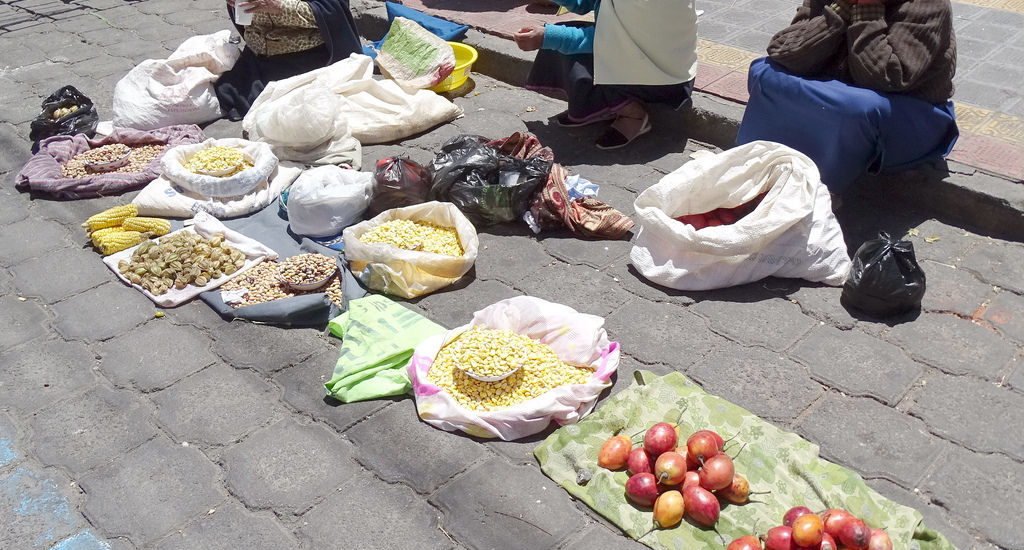The populations of South America, and in particular those of the Andean regions, had selected, before the Spanish conquest, a considerable number of plants for food purposes. In fact, in their vast empire, the Incas had developed an extremely diversified agriculture, suitable for the remarkable variety of ecosystems (from the arid coastal plain to the plateaus, to the rainforest); a profitable agriculture capable of satisfying the food needs of a population of around 12 million. Some of the cultivated plants, especially corn, potatoes and tomatoes, were imported by the Spanish conquerors and found fast and widespread, so as to vary the eating habits and agricultural in Europe and later in the rest of the world, others, disdained by “conquistadors” went irretrievably lost when their agriculture fell into disuse, while others continued to be cultivated and sold in the markets of small villages on the Andean highlands. The selection criterion by the Spaniards was based essentially on the adaptability of these to food preparations that are more in keeping with European tastes, therefore some plants with a high nutritional value did not encounter the same spread of the potato and corn. Currently their cultivation is relegated almost exclusively to the original places and their use is limited to small geographical areas.
The current interest in food plants native to South America lies not only in more than 200 known species and used in different countries, but especially in the food potential of about 8000 Amazon species used almost exclusively by the ethnic groups of this immense region and among which it is possible to find some plants with a high nutritional and economic value. The study of nutritional properties through chemical composition and the consequent development on a wider territory could certainly contribute to the discovery of new food sources also in consideration of the fact that such plants show more often modest agronomic requests.
So, over thousands of years, American indigenous peoples domesticated and cultivated a wide range of plant species for food. These species now represent 50-60% of all crops in the world. The potato is an example, as well as the tomato (Lycopersicon esculentum) native to Mexico, but with many other varieties in the Andean regions. There are, however, many other important food species that are cultivated only in the Andean areas that are little known scientifically. Among these tubers and tubercles of high nutritional value such as Ullucus tuberosus (Basellaceae), Oxalis tuberose, (Oxalidaceae), Tropaeolum tuberosum (Tropaeolaceae), Arracacia xanthorriza (Apiaceae), Canna edulis (Cannaceae), Lepidium meyenii (Brassicaceae), Mirabilis distesa (Nyctaginaceae) and Polymnia sonchifolia (Asteraceae). Each of these species, with low agronomic needs, is potentially a new crop for other areas of the world. Other important crops include high-protein pseudo-cereals, such as quinoa, Chenopodium quinoa (Chenopodiaceae) and C. pallidicaule, Amaranthus caudatus (Amarantaceae) known as kiwicha and a high-protein legume, the Lupinus mutabilis (Fabaceae ). These species have for centuries been among the main food sources of the Andean region of the plateau and in particular the only source of protein, as meat and milk consumption are not common in those regions. They found no interest among the Spanish rulers and their cultivation was relegated to the Andean regions. Today there are at least 30 species of roots and tubers originating in South America, belonging to 18 botanical genera and 16 families including mono / e dicotyledons representing the widest range of diversity of tuber crops and roots in terms of taxonomic affiliation and adaptation. ecological than any other part of the world.
Even in rainforests and tropical forests, there are many plants, trees and fruits used as a food source. The jippi jappa Palm (Sabal mexicana, Palmaceae) is an important plant used by the Mopan Mayan and Kekchi ethnic groups, as well as the original palm and asparagus of the rainforest and the Caribbean coast of Central America. Their drupes and palm hearts are consumed in various recipes. Bactris major (common name kawmaka, Arecaceae) is a small to medium-sized thorny palm (1-10 m high) spread from Mexico, to Central America to North America and the south of Trinidad. Fruits are eaten or used to flavor drinks. Bacipis gasipaes, also known in Costa Rica as pejibaye, chontaduro in Venezuela, piba in Panama, pupunha in Brazil and fishing palm in English-speaking countries, has an important nutritional value, mainly due to the presence of starches and oils and high energy content and nutritional, similar to that obtained from corn.
The Gliricidia sepium (common name, mother cacao) is a 3 to 10 m tall tree belonging to the Fabaceae family. It is native to both the coasts of Mexico, above half of the country to the south and through Central America, to Colombia and Venezuela. G. sepium is used both at the medical level and for the feeding of livestock in the coastal areas of the Pacific, Mexico, Central America and in the tropical regions of South America and Asia. Its leaves are generally considered one of the most digestible of tropical fodder legumes and contain a high content of easily degradable proteins and carbohydrates. It is considered the second most important multi-purpose legume tree, surpassed only by Leucaena leucocephala. Leaves and roots contain saponins, isoflavonoids and flavonoids. Also the Byrsonima crassifolia (Malpighiaceae), native of tropical America, is appreciated for its small, sweet yellow fruits, which are strongly fragrant. The fruits, also called nance, are eaten raw or cooked as desserts. In the rural area of Panama, the dessert prepared with the addition of sugar and flour, known as pesada de nance, is very popular. The fruits are also transformed into dulce de nance, a candy prepared with fruit cooked in sugar and water.
Many cultures first domesticated by indigenous Americans are now produced and / or used globally. The main among these is corn, the most important crop in the world. Other significant crops include cassava, squash, zucchini, beans, tomato, potatoes, avocados, peanuts, cocoa, gum, and some species of cotton. Of course, bananas, coffee and cocoa are the main crops of Central America, but even non-traditional export crops are playing an increasingly important role in the economic development of Central America. This relatively new market-driven development opportunity has been the fastest growing sector of agricultural industries in Central America, with an average annual growth rate of 16% between 1983 and 1997 and 28% from 2000 to 2010.









